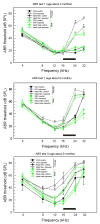Effects of exposing gonadectomized and intact C57BL/6J mice to a high-frequency augmented acoustic environment: Auditory brainstem response thresholds and cytocochleograms
- PMID: 16973316
- PMCID: PMC1831842
- DOI: 10.1016/j.heares.2006.07.016
Effects of exposing gonadectomized and intact C57BL/6J mice to a high-frequency augmented acoustic environment: Auditory brainstem response thresholds and cytocochleograms
Abstract
Gonadectomized and surgically intact adult C57BL/6J (B6) mice of both sexes were exposed for 12h nightly to a high-frequency augmented acoustic environment (AAE): repetitive bursts of a half-octave noise band centered at 20 kHz, 70 dB SPL. The effects of sex, gonadectomy, and AAE treatment on genetic progressive hearing loss (exhibited by B6 mice) were evaluated by obtaining auditory brainstem response thresholds at ages 3-, 6-, and 9-months; hair cell counts (cytocochleograms) were obtained at 9 months. A sex difference in the rate of genetic progressive hearing loss in B6 mice (observed by earlier studies) was confirmed, with females exhibiting a faster rate of threshold elevations and more severe loss of hair cells at age 9 months. Gonadectomy had no consistent effects on the rate or severity of hearing loss in non-exposed mice of either sex. An unexpected finding was that the high-frequency AAE treatment caused additional ABR threshold elevations and hair cell loss. In an earlier study, the same high-frequency AAE treatment on DBA/2J mice ameliorated hearing loss. The most severe AAE-induced losses occurred in surgically intact females, suggesting a potentiating effect of ovarian hormone(s).
Figures




Similar articles
-
Effects of sex, gonadal hormones, and augmented acoustic environments on sensorineural hearing loss and the central auditory system: insights from research on C57BL/6J mice.Hear Res. 2009 Jun;252(1-2):89-99. doi: 10.1016/j.heares.2008.12.002. Epub 2008 Dec 14. Hear Res. 2009. PMID: 19114100 Free PMC article.
-
Effects of exposing C57BL/6J mice to high- and low-frequency augmented acoustic environments: auditory brainstem response thresholds, cytocochleograms, anterior cochlear nucleus morphology and the role of gonadal hormones.Hear Res. 2008 Jan;235(1-2):60-71. doi: 10.1016/j.heares.2007.10.006. Epub 2007 Nov 13. Hear Res. 2008. PMID: 18077117 Free PMC article.
-
Effects of exposing DBA/2J mice to a high-frequency augmented acoustic environment on the cochlea and anteroventral cochlear nucleus.Hear Res. 2006 Jun-Jul;216-217:138-45. doi: 10.1016/j.heares.2006.01.010. Epub 2006 Feb 23. Hear Res. 2006. PMID: 16497456
-
Genetic influences on susceptibility of the auditory system to aging and environmental factors.Scand Audiol Suppl. 1992;36:1-39. Scand Audiol Suppl. 1992. PMID: 1488615 Review.
-
The effect of acoustic trauma on the tectorial membrane, stereocilia, and hearing sensitivity: possible mechanisms underlying damage, recovery, and protection.Scand Audiol Suppl. 1988;27:1-45. Scand Audiol Suppl. 1988. PMID: 3043645 Review.
Cited by
-
Acoustic experience alters the aged auditory system.Ear Hear. 2013 Mar-Apr;34(2):151-9. doi: 10.1097/AUD.0b013e318269ca5b. Ear Hear. 2013. PMID: 23086424 Free PMC article.
-
Threshold sound conditioning in the treatment of sensorineural hearing loss.Laryngoscope Investig Otolaryngol. 2020 May 18;5(3):438-444. doi: 10.1002/lio2.399. eCollection 2020 Jun. Laryngoscope Investig Otolaryngol. 2020. PMID: 32596485 Free PMC article.
-
Effects of sex, gonadal hormones, and augmented acoustic environments on sensorineural hearing loss and the central auditory system: insights from research on C57BL/6J mice.Hear Res. 2009 Jun;252(1-2):89-99. doi: 10.1016/j.heares.2008.12.002. Epub 2008 Dec 14. Hear Res. 2009. PMID: 19114100 Free PMC article.
-
Estrogen Replacement Reduces Hearing Threshold Shifts and Cochlear Hair Cell Loss After Acoustic Overexposure in Ovariectomized Rats.Clin Exp Otorhinolaryngol. 2021 Feb;14(1):61-68. doi: 10.21053/ceo.2019.01662. Epub 2020 May 15. Clin Exp Otorhinolaryngol. 2021. PMID: 32407615 Free PMC article.
-
Automated threshold detection for auditory brainstem responses: comparison with visual estimation in a stem cell transplantation study.BMC Neurosci. 2009 Aug 26;10:104. doi: 10.1186/1471-2202-10-104. BMC Neurosci. 2009. PMID: 19706195 Free PMC article.
References
-
- Arnold AP. Genetically triggered sexual differentiation of brain and behavior. Horm Behav. 1996;30:495–505. - PubMed
-
- Belisle S, Bellabarba D, Lehoux JG. Age-dependent, ovary-independent decrease in the nuclear binding kinetics of estrogen receptors in the brain of the C57BL/6J mouse. Amer J Obstet Gynecol. 1985;153:394–401. - PubMed
-
- Bergman MD, Karelus KK, felicio LS, Nelson JF. Differential effects of aging on estrogen receptor dynamics in hypothalamus, pituitary and uterus of the C57BL/6J mouse. J Steroid Biochem. 1989;33:1027–1033. - PubMed
-
- Bittar RS, Cruz OL, Lorenzi MC, Marone SA, Miniti A. bregm1. Morphological and functional study of the cochlea after administration of estrogen and progesterone in the guinea pig. Int Tinnitus J. 7:41–45. - PubMed
-
- Coleman JR, Campbell D, Cooper WA, Welsh MG, Moyer J. Auditory brainstem responses after ovariectomy and estrogen replacement in rat. Hear Res. 1994;80:209–215. - PubMed
Publication types
MeSH terms
Grants and funding
LinkOut - more resources
Full Text Sources
Medical
Miscellaneous

